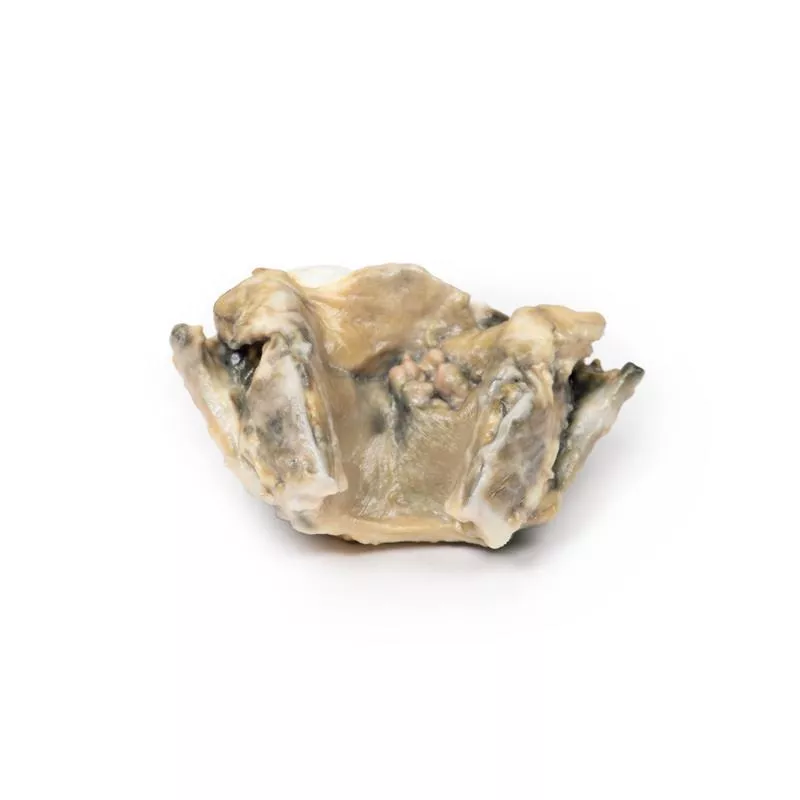Produktinformationen "Tracheoesophageal Fistula and Oesophagus Atresia"
Klinische Vorgeschichte
Eine 32-jährige Frau kam in vorzeitiger Wehentätigkeit in der 25. Schwangerschaftswoche ins Krankenhaus. Das Kind wies Polydaktylie, einen imperforierten Anus, vermehrten Speichelfluss sowie ein lautes pansystolisches Herzgeräusch auf. Zudem wurde eine einzelne Nabelarterie festgestellt. Das Neugeborene hatte Schluckprobleme und Atemnot und verstarb nach zwei Tagen an einer Aspirationspneumonie.
Pathologie
Das Präparat umfasst Zunge, Kehlkopf, Trachea, Bronchien, beide Lungen und die Speiseröhre. Sichtbar ist eine Typ-C-Tracheoösophageale Fistel knapp oberhalb der Bifurkation, die den unteren Ösophagus mit der Trachea verbindet. Eine mögliche Ösophagusatresie ist schwer zu beurteilen.
Weitere Informationen
Tracheoösophageale Fisteln (TEF) treten bei etwa 1 von 4000 Neugeborenen auf. Typ C (Ösophagusatresie mit distaler Fistel) ist mit 86?% am häufigsten. Ursache ist eine fehlerhafte Trennung des Vorderdarms in Speise- und Luftröhre. Häufig sind Syndrome wie VACTERL oder CHARGE beteiligt. Pränatal können Polyhydramnion und ein nicht sichtbarer Magen auffallen. Nach der Geburt zeigen sich vermehrter Speichelfluss, Atemnot, Fütterungsschwierigkeiten und Würgen. Die Diagnose erfolgt über Magensonden-Test und Bildgebung. Die operative Korrektur ist meist erfolgreich, die Prognose hängt jedoch von Begleitfehlbildungen und der Frühgeburtlichkeit ab.
Eine 32-jährige Frau kam in vorzeitiger Wehentätigkeit in der 25. Schwangerschaftswoche ins Krankenhaus. Das Kind wies Polydaktylie, einen imperforierten Anus, vermehrten Speichelfluss sowie ein lautes pansystolisches Herzgeräusch auf. Zudem wurde eine einzelne Nabelarterie festgestellt. Das Neugeborene hatte Schluckprobleme und Atemnot und verstarb nach zwei Tagen an einer Aspirationspneumonie.
Pathologie
Das Präparat umfasst Zunge, Kehlkopf, Trachea, Bronchien, beide Lungen und die Speiseröhre. Sichtbar ist eine Typ-C-Tracheoösophageale Fistel knapp oberhalb der Bifurkation, die den unteren Ösophagus mit der Trachea verbindet. Eine mögliche Ösophagusatresie ist schwer zu beurteilen.
Weitere Informationen
Tracheoösophageale Fisteln (TEF) treten bei etwa 1 von 4000 Neugeborenen auf. Typ C (Ösophagusatresie mit distaler Fistel) ist mit 86?% am häufigsten. Ursache ist eine fehlerhafte Trennung des Vorderdarms in Speise- und Luftröhre. Häufig sind Syndrome wie VACTERL oder CHARGE beteiligt. Pränatal können Polyhydramnion und ein nicht sichtbarer Magen auffallen. Nach der Geburt zeigen sich vermehrter Speichelfluss, Atemnot, Fütterungsschwierigkeiten und Würgen. Die Diagnose erfolgt über Magensonden-Test und Bildgebung. Die operative Korrektur ist meist erfolgreich, die Prognose hängt jedoch von Begleitfehlbildungen und der Frühgeburtlichkeit ab.
Erler-Zimmer
Erler-Zimmer GmbH & Co.KG
Hauptstrasse 27
77886 Lauf
Germany
info@erler-zimmer.de
Achtung! Medizinisches Ausbildungsmaterial, kein Spielzeug. Nicht geeignet für Personen unter 14 Jahren.
Attention! Medical training material, not a toy. Not suitable for persons under 14 years of age.






































